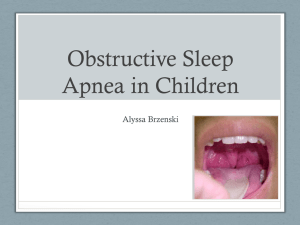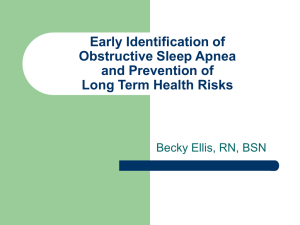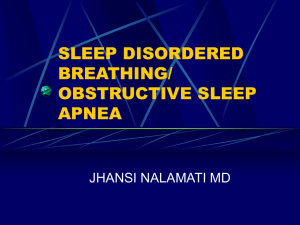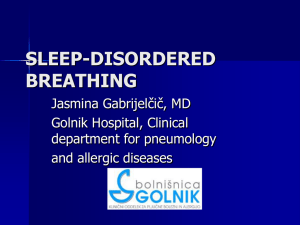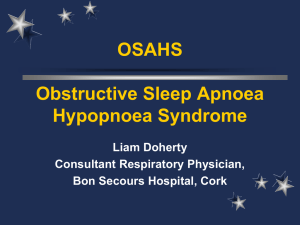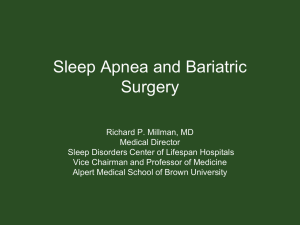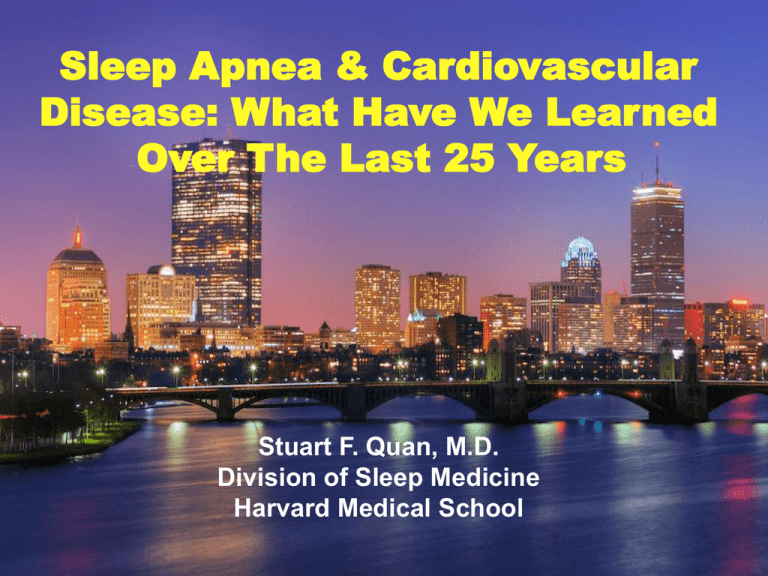
Sleep Apnea & Cardiovascular
Disease: What Have We Learned
Over The Last 25 Years
Stuart F. Quan, M.D.
Division of Sleep Medicine
Harvard Medical School
Sleep Medicine
Overview
• Obstructive sleep apnea-- a bit of
history
• OSA and CVD: Biological
plausibility/physiology
• Time machine to ~1970s-80s: What we
knew then
• Present time: What we know now
• Current knowledge gaps
• Clinical Trials: Opportunities to Address
Knowledge Gaps
Sleep Medicine
Sleep Apnea in Antiquity
• Dionysius………..
So his physicians prescribed he should
get some fine needles, exceedingly
long, which they thrust through his ribs
and belly whenever he happened to fall
into a deep sleep…then he would be
thoroughly aroused.
Historical Medical Accounts
of Sleep Apnea
When a person, especially advanced in years, is lying on his back in
heavy sleep and snoring loudly, it very commonly happens that every
now and then the inspiration fails to overcome the resistance in the
pharynx, of which stridor or snoring is the audible sign, and there will
be perfect silence through two, three, or four respiratory periods, in
which there are ineffectual chest movements; finally air enters with a
loud snort, after which there are several compensatory deep
inspirations…..
Broadbent, WH
Lancet, 1877
Burwell et al, Am J Med 1956
Sleep Medicine
Why Might OSA be a Risk
Factor for CVD?
Sleep Medicine
Physiological Consequences
•
Intrathoracic Pressure Changes
–
Preload, afterload and transmural pressure
–
Trigger baroreceptors
•
Hypoxemia, hypercapnia, and arousal
–
SNS overdrive
–
Systemic and Pulmonary Vasoconstriction
–
Abnormal HRV and increased HR
Sleep Medicine
Negative Intrathoracic Pressure
Swings
•Increased preload
•Increased LV afterload
(increased transmural
pressure)
•Impaired diastolic
function
•Atrial and aortic
enlargement
Tracheal Pressure
(mmHg)
LV Pressure
(mmHg)
LV Transmural
Pressure
(mmHg)
LV End Systolic
Volume (mL)
Parker Am J Respir Crit Care Med 1999; 160: 1888-96.
Sleep Medicine
State of Affairs 1970’s-1980’s
or otherwise “What I knew when I
was an intern?”
Sleep Medicine
1970s and 1980s
Sleep Medicine
Circa ~1980s
Ann Intern Med. 1985 Aug;103(2):190-5.
Sleep Medicine
Snoring and Hypertension
in San Marino
N=5713
Lugaresi et al, Sleep 1980; 3:221-4
Snoring and Hypertension:
Finnish Twin Study
N=3847
KOSKENVUO et al, Lancet, 1985
N=3664
Koskenvuo M, BMJ, 1987
N=4388 men
Boudoulas H, et al. J Med 1983:14:223-38
Sleep Medicine
Effect of AI on Mortality
He et al, Chest 94:9-14, 1988
Sleep
Medicine
Partinen
et al
Chest 1988
No Increase in Mortality in
OSA Patients
•
•
•
•
Circa 1988
91 patients with treated and untreated
OSA
35 patients with symptoms of OSA, but
negative PSG
Retrospective f/u for 7-98 months
Mortality
– 4/35 (11.4%) Controls and 9/91 (9.8%) OSA
patients
Gonzalez-Rothi et al, Chest, 1988
Acute Hemodynamic
Changes with OSA
Cyclical increases in ABP
Cyclical increases in PAP
Apnea
Schroeder et al, in Sleep Apnea Syndromes, 1978
Sleep Medicine
Cardiovascular
Pathogenesis of OSA--1976
Tilkian et al, Ann Intern Med 1976
State of Affairs 2011
or otherwise “What do wise men
and women know now?”
Sleep Medicine
SDB and Incident Hypertension
Adjusted Odds Ratios for Hypertension at Follow-up
Odds
5
Ratio 4.5
4
3.5
3
2.5
2
1.5
1
0.5
0
0 /hr
0.1-4.9 /hr
5-14.9 /hr
>15 /hr
Adj BL Htn Adj Age/Sex
Full Adj
Peppard et al, N Engl J Med 2000; 342:1378
Gottlieb et al, Circulation 2010
Incident CHD and OSA
Although there was an increased risk of incident
CHD in clinic-derived samples, those who were
treated with CPAP had the same risk as controls
Treated with CPAP
12 year follow-up
All Men
N=1651
No CPAP
Marin, Lancet 2005
Major Adverse Cardiovascular
Events (MACE) In Patients with
CAD and OSA
• 407 consecutive patients with CAD
• 38% with ODI >5
• Increased 5-year MACE
– ♂ AHI ≥10: 28% vs. 16%
– ♀ AHI ≥ 10: 20% vs. 14%
Mooe T AJRCCM 2001:164
OSA Increases Risk of MACE and Restenosis After Percutaneous Coronary
Intervention
• 89 consecutive pts with ACS followed
for mean 227 days,
– 57% OSA (AHI>10)
– Higher CRP but otherwise comparable
• MACE in OSA vs non-OSA:
– 23.5% vs. 5.3%
– HR: 11.6 (2.2,62.2)
• Quantitative Coronary Arteriography
– Late Loss: 1.28 vs 0.69 mm MLD
– Binary restenosis: 37% vs 15%
Yumino, D. AJC 2007:99
Gottlieb et al, Circulation 2010
All Cause Mortality:
Busselton Health Study*
RDI ≥15/hr, 6 deaths,
HR = 6.24,
95% CL 2.01, 19.39
*N=380
Marshall et al, Sleep. 2008 August 1; 31(8): 1079–1085
All Cause Mortality: Wisconsin
Sleep Cohort*
Young et al, Sleep. 2008 August 1; 31(8): 1071–1078
*N=1496,
CPAP Treated Excluded
Sleep Apnea and All-Cause Mortality in SHHS
Survival Probability
1.0
0.9
Apnea-hypopnea index
(events/hr)
< 5.0
5.0 – 14.9
15.0 – 29.9
> 30.0
0.8
0.7
0
1
2
3
4
5
6
7
8
9
10
5411
757
4756
875
2357
989
300
1046
Years
Numbers at risk: 6294
Total Deaths:
0
6205
59
6110
143
Punjabi et al, PLOS Med 2009
6001
241
5868
359
5732
478
5566
616
Nocturnal Predilection for
Sudden Cardiac Death in OSA
N=112
Gami AS NEJM 2005:352
Adjusted Odds Ratio of Nocturnal Arrhythmia
By Sleep Apnea (AHI>30) In SHHS
Adjusted OR 95% CI
Atrial Fibrillation
4.5
1.2, 17
CVE or NSVT
1.8
1.2, 2.8
AF or NSVT
3.7
1.7, 8.0
Odds > 7.0 for those 50 to 60 years old
Mehra R AJRCCM 2006
Case-Cross-Over Study: Relative Risk of a Paroxysmal Arrhythmia
Occurring After an Apnea/Hyponea: 17
Monahan JAAC 2008
Absolute Risk of Nocturnal
Arrhythmias In Association with
Apneas in SHHS
1 excess episode of PAF or NSVT for
every 1000 hours of sleep or 40000
respiratory disturbances
For a person with moderate Sleep
Apnea (AHI = 25 events/hour) sleeping
8 hours/night
1 excess arrhythmia in 7 months
Obstructive Sleep Apnea and Recurrence of AFib
Recurrence of AFib (12 mo)
118 pt – successful
cardioversion
100
P=0.013
80
Sleep apnea – CPAP
(n=12)
Sleep apnea – no
CPAP (n=27)
Controls – no sleep
study
Pt
(%)
P=0.009
82
60
53
40
42
20
0
Untreated pt – mean
nocturnal fall in O2 sat
• Recurrence – 18%
P=0.034
• No recurrence – 8%
Kanagala and Somers
Sleep Medicine
CP1073966-6
OSA and CVD
Mechanistic Observations
Sleep Medicine
OSA and Cardiac Morphology
• SHHS (n=2058), AHI < 5 vs AHI > 30
• Adjusted LVMI 7% higher: 41. 3 vs 44.1 g/m 2.7
• LVH: Odds Ratio: 1.78 (1.14, 2.79, 95% CI)
• Increased LVIDd
• Eccentric Hypertrophy
– Stronger associations with hypoxemia indices vs
AHI
Chami et al. Circulation. 2008. 117:2599
Impaired LV Diastolic Function
• Cross-sectional Findings
– 15 controls; 27 OSA (Avg AHI
44)
– No co-morbidities
• OSA: 56% abnormal LV
• 12 week intervention
– CPAP vs sham
– Improved E/A, IVRT, mitral DT
– No change in BP,
catecholamines
– Longer IVRT and DT and lower
E/A
41% Impaired
Relaxation
Arias MA Circulation 2005:112:375
Prevalence of Metabolic Syndrome
in OSA vs non OSA Patients
**
80
70
60
*
50
OSA
40
No OSA
30
20
10
0
Met Syn
Htn
Dyslipid
Parish et al, J Clin Sleep Med 2007;3: 467–472
DM
BMI
Sleep Apnea and Oxidative
Stress
• Recurrent hypoxia and reoxygenation
– Increase flux of free radicals
– Induce endothelin expression
– Suppress NO generation
– Induce local vasoconstriction and
changes in vascular permeability
• Results in oxidative stress causing
generation of ROS (superoxide)
Prabhakar NR, JAP, 2001
Pro-Inflammatory and Atherogenic
Effects
• Upregulation of inflammatory mediators
• IL6, sIL6R, IL-8, TNFα, CRP,
(NF-Kappa B)
• Enhanced thrombotic potential
– PAI-1, P-selectin, fibrinogen,
– VEGF
• Oxidation of serum proteins and lipids
• Endothelial dysfunction
• Insulin Resistance and Dyslipidemia
Hansson NEJM 352: 2005
Savransky AJRCCM 2007: 177
Savransky Circ Res 2008:103
Intermittent
Hypoxia
Atherosclerosis
IA, Nl diet
IA, H Fat
Loresnzi-Filho AJRCCM 2007:175
↑hepatic HIF-1
Hypoxic inducible factor 1
SREBP-1
sterol regulatory element–binding protein-1
+ high fat diet
Dyslipidemia
SCD-1
TNFα gene
stearoyl-Coenzyme A desaturase 1
CIH, Nl diet
CIH, H Fat
Mice: CIH + fat diet> ↑ 70% SCD-1 mRNA,
VLDL, atherosclerosis
(reversed by blocking SCD-1)
Est 12 wks CIH in M~1 yr HC Diet in F
Humans: hepatic SCD-1 α overnight
hypoxemia (r=.68)
PHYSIOLOGIC
PERTURBATIONS
Chronic
Intermittent
Hypoxia
Ventilatory
Overshoot
Hyperoxia
SLEEP-Apnea
Increased
Sympathetic
Nervous System
Activity
Intrathoracic
Pressure
Swings
Hypercapnia
Increased
Arousals
Reduced Sleep
Duration
Mehra R Curr Resp Med Rev 2007
INTERMEDIATE
MECHANISMS
Increased
Inflammation
Increased
Oxidative
Stress
Metabolic
Dysfunction/
CLINICAL
OUTCOMES
Systemic
Hypertension
Atherosclerosis
Diastolic
Dysfunction
Congestive Heart
Failure
Insulin
Resistance
Stroke
Hypercoaguability
Increased
Mortality and
Sudden Death
Endothelial
Dysfunction
Autonomic
Dysfunction
Cardiac
Arrhythmias
OSA and CVD:
Knowledge Gaps
• Hypertension
– Does treatment of OSA reduce incident hypertension?
– In whom does treatment of OSA significantly lower
BP?
• Coronary Heart Disease/CHF/Stroke
– Does adverse impact of OSA affect only men?
– Does treatment of OSA decrease risk of
CHD/CHF/Stroke?
– What treatments will be effective?
• Mortality
– Does treatment of OSA decrease mortality risk?
Sleep Medicine
Lack of Interventional RCTs (1)
• No published large scale interventional RCTs on
benefit of OSA treatment on CVD/Mortality
• RICCADSA: Randomized Intervention with CPAP
in Coronary Artery Disease and Sleep Apnoea
– 400 CAD ppts: 100 each to 1) non-sleepy OSA/CPAP, 2) nonsleepy OSA/no CPAP, 3) sleepy OSA/CPAP, 4) CAD but no OSA
– Follow-up for 3 years for CVD morbidity and mortality
– Scand Cardiovasc J. 2009 Feb;43(1):24-31.
• HEARTBEAT: Randomize ~270 ppts with stable
CAD or high risk for CAD to CPAP, O2 or healthy
lifestyle
Sleep Medicine
Lack of Interventional RCTs (2)
• Sleep Apnea Cardiovascular Endpoints Study
(SAVE)
– Multinational randomised, controlled trial to
determine the effects of nasal continuous positive
airway pressure (CPAP) in preventing
cardiovascular (CV) disease in high risk patients
with moderate-severe obstructive sleep apnea
(OSA)
– Plan to randomize >5000 ppts to CPAP or CMT
and follow for 3-5 years
– Sites in Australia, New Zealand, China, India and
South America
Sleep Medicine
• BestAIR: Best Apnea Interventions In Research
– Prepares for Phase 3 study
• Sham vs CMT as control arms
• CBT-guided CPAP adherence vs RT-guided adherence
• Control vs Active PAP – 24 BP, cardiac function, biomarkers
• ABC: Apnea, Bariatric Surgery, and CPAP Trial
– Bariatric surgery as a first line treatment
(vs CPAP)
• COMET: Comparative Effectiveness CPAP Management
– Oral Appliances vs CPAP in women with OSA
Sleep Medicine
Final Thoughts
• Substantial progress has been made in the
past 25-30 years in our understanding of the
OSA/CVD relationship
• Accumulating evidence implicates SDB as an
independent risk factor for hypertension, CHD
and Stroke
• Risk may not be the same for all segments of
the population
• Treatment appears to mitigate the risk in
some clinical populations
• Unclear whether treatment is beneficial in
patients without symptoms
SLEEP MEDICINE
GOT SLEEP?
http://understandingsleep.org
“Healthy Sleep” web site launched January 2008
“Apnea” coming April 2011
Presented by: Harvard Medical School
Division of Sleep Medicine
& WGBH Educational Foundation
GOT SLEEP? Get it at http://understandingsleep.org

